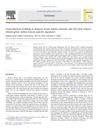natural substance from Neem tree with medicinal and pesticidal properties
signaling protein that, when suppressed, may grow hair by reducing inflammation and stem cell loss
autoimmune disorder causing patchy hair loss
bioflavonoid found in plants with antioxidant and hair stimulating properties





